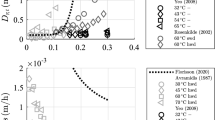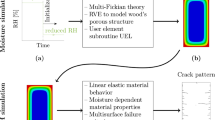Abstract
Numerical modelling was used to follow the evolution of the moisture content gradient and the stress field resulting from the restrained differential dimensional response across a wooden cylinder, simulating sculptures, in response to variations in temperature (T) and relative humidity (RH). Material properties of lime wood (Tilia sp.) were used in the modelling as this wood species was historically widely used. The allowable RH variations, below which mechanical damage will not occur, were derived as functions of the amplitude, time period and starting RH level of the variation. Lime wood can endure step RH variations of up to 15% in the moderate RH region, but the allowable domain narrows when RH levels shift from the middle range. The allowable amplitude of the variations increases when time allowed for the change increases. The stress field does not vanish even for slow, quasi-static changes in RH due to structural internal restraint resulting from the anisotropy in the moisture-related dimensional change.













Similar content being viewed by others
References
Green DW, Winandy JE, Kretschmann DE (1999) Mechanical properties of wood. In: Wood Handbook, Wood as an engineering material (Chap 4), Forest Products Society, Madison
ISO Standard 3346 (1985) Wood. Determination of ultimate tensile stress perpendicular to grain
Kowalski SJ, Molinski W, Musielak G (2004) The identification of fracture in dried wood based on theoretical modeling and acoustic emission. Wood Sci Technol 38:35–42
Mecklenburg MF, Tumosa ChS, Erhardt D (1998) Structural response of painted wood surfaces to changes in ambient relative humidity. In: Dorge V, Howlett FC (eds) Painted wood: history and conservation. The Getty Conservation Institute, Los Angeles, pp 464–483
Padfield T (1999) On the usefulness of water absorbing materials in museum walls. In: 12th Triennial Meeting of the Committee for Conservation of the International Council of Museums. James and James Science Publishers Ltd, London, pp 83–87
Peralta PN, Bangi AP (1998) Modeling wood moisture sorption hysteresis based on similarity hypothesis. Part 1. Direct approach. Wood Fiber Sci 30:48–55
Press WH, Tenkolsky SA, Vetterling WT, Flannery BP (1992) Numerical recipes in C, 2nd edn. Cambridge University Press, Cambridge
Simpson W, TenWolde A (1999) Physical properties and moisture relations of wood. In: Wood Handbook, Wood as an engineering material (Chap 3), Forest Products Society, Madison
Svensson S, Toratti T (2002) Mechanical response of wood perpendicular to grain when subjected to changes of humidity. Wood Sci Technol 36:145–156
Time B (2002) Studies on hygroscopic moisture transport in Norway spruce (Picea abies) Part 1: sorption measurements of spruce exposed to cyclic step changes in relative humidity. Holz Roh- Werkst 60:271–276
Toratti T, Svensson S (1997) Mechano-sorptive experiments perpendicular to grain under tensile and compressive loads. Wood Sci Technol 34:317–326
Vici PD, Mazzanti P, Uzielli L (2006) Mechanical response of wooden boards subjected to humidity step variations: climatic chamber measurements and fitted mathematical models. J Cult Herit 7:37–48
Acknowledgments
A substantial part of this research was done within two projects supported financially by the European Commission 6th Framework Programme: “Global climate change impact on built heritage and cultural landscapes” (NOAH’S ARK) and “Sensor systems for detection of harmful environments in pipe organs” (SENSORGAN). Further, this work was supported in part by grant 1 H01E 010 30 from the Polish Ministry of Science and Higher Education.
Author information
Authors and Affiliations
Corresponding author
Rights and permissions
About this article
Cite this article
Jakieła, S., Bratasz, Ł. & Kozłowski, R. Numerical modelling of moisture movement and related stress field in lime wood subjected to changing climate conditions. Wood Sci Technol 42, 21–37 (2008). https://doi.org/10.1007/s00226-007-0138-5
Received:
Published:
Issue Date:
DOI: https://doi.org/10.1007/s00226-007-0138-5




